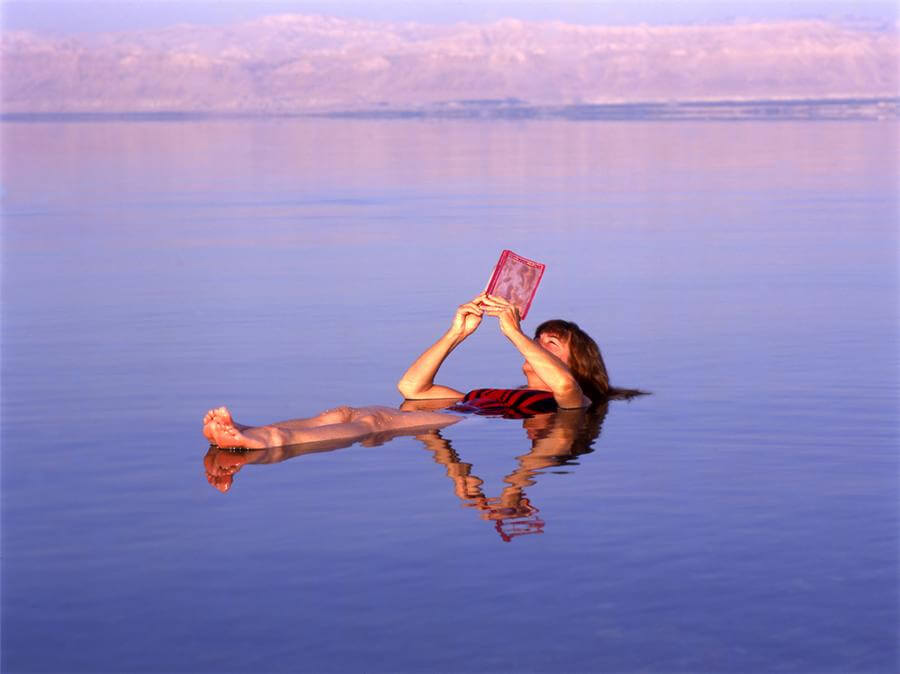The Dead Sea is a lake fed by the Jordan River and in ancient times it was known by many names such as the Salt Sea, the Eastern Sea, and the Sea of Sodom. Most of the names reference the fact that its salt and mineral content is 30% to 40%, while the oceans salt content is around 6%. Only about 2 inches of rain fall each year, but there are occasional and fierce thunderstorms. The sea is called "dead" because its high salinity means no macroscopic aquatic organisms such as fish or water plants can live in it, though minuscule quantities of bacteria and microbial fungi are present.
Situated on the heart of the Great Syrian-African rift valley that stretches throughout Israel and beyond, the Dead Sea is the lowest point on the earth, 1,320 feet below sea level and is flanked by the Judean Mountains on the west, the Hashemite Kingdom of Jordan and the Mountains of Moab on the east, the Jordan Valley and Sea of Galilee to the north and the Negev Desert as well as the Red Sea to the south.
The human history of the Dead Sea goes all the way back to remote antiquity. Just north of the Dead Sea is Jericho, the oldest continually occupied town in the world. The Greeks knew the Dead Sea as Lake Asphaltites, due to the naturally surfacing asphalt. Aristotle wrote about the remarkable waters. The Dead Sea is also the location of the Qumran community which produced the Dead Sea Scrolls. These ancient texts, preserved in sealed caves near the shore of the Dead Sea, provide remarkable insight on the religious and social beliefs of 1st-century Jews. King Herod the Great built and re-built several fortresses and palaces on the Western Bank of the Dead Sea. The most famous was Masada, where, in 66-70 AD, a small group of rebellious Jewish zealots held out against the might of the Roman Legion, and Machaerus where, it is believed John the Baptist had been imprisoned by Herod Antipas and met his death.
The water of the Dead Sea contains 21 minerals including magnesium, calcium, bromine and potassium. Twelve of these are found in no other area or ocean and some are recognized for imparting a relaxed feeling, nourishing the skin, activating the circulatory systems and for easing rheumatic discomfort and metabolic disorders. As an example, the Dead Sea contains 10 times more salts and minerals than the Mediterranean Sea. The high salt and mineral concentration enables everyone to float in its waters but doesn't allow the proliferation of fish and other marine life.
Black Mud is a signature element of the Dead Sea and is homogeneous mixture of Dead Sea minerals, important organic elements from the shoreline as well as earth. Indulging in a black mud body wrap has both cosmetic and therapeutic benefits that are known to cleanse and stimulate the skin, relieve muscle and emotional tensions, improve blood circulation, and ease rheumatic pain. The rich minerals and the mud tightening action promote circulation by increasing the supply of oxygen to and removing the toxins from the skin, thus toning and firming up skin tissues, leaving the skin glowing and youthful looking. Dead Sea Mineral Mud cleans, purifies, and restores the skin's natural minerals.
As the name suggests, the Dead Sea is devoid of life due to an extremely high content of salts and minerals. It is these natural elements which gave the water its curative powers. Dead Sea Salt and Dead Sea Mud have been recognized by millions of people as a single source of health and beauty since the days of Herod the Great, more than 2,000 years ago. It is said that Queen Cleopatra obtained exclusive rights to build cosmetic and pharmaceutical factories in the area. The Dead Sea's salinity and mineral composition improves cell metabolism and contributes to its restoration and regeneration. Dead Sea Salt also acts as a disinfectant and help in removing harmful substances from the skin.




